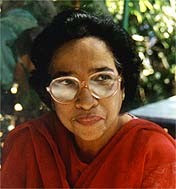
.
Not very far from the Champs Elysees in Paris, is the Cemetery de Passy. It sits in the shadow of the Eiffel Tower, well concealed from the world by thick branches of chestnut trees. No ordinary tourist would like to venture into this overcrowded necropolis. Its confusion of bizarre mausoleums with doors and candelabras is something of a nightmare to negotiate. It was a small area in 1820, But by 1874, it became the final resting place of the rich and the famous. Here in the silent company of Chopin, Oscar Wilde, Debussy and many fellow painters and artists like Manet, lies Berthe Morisot, the artist whom France forgot.
Born on January 14th, 1841 at Bourges, Cher, Berthe was inclined towards painting since her childhood. Perhaps she had inherited these genes from her grand uncle the famous Rococo painter Fragonard. Her parents supported her in her desire to pursue painting, and arranged for painting lessons. She began to copy the old Masters perfectly. Her skills were recognized by the greater artist Corot, under whom she studied from 1860 – 1862. He encouraged her to attend the Auvers-sur-Oise, to learn the technique of Plein Air painting.
Berthe was the first female Impressionist painter. She knew how to capture the effect of light falling on objects. The interplay of light and shadow were beautifully reproduced in her paintings. She drew landscapes directly from Nature and was not studio-bound. In 1864, at the age of 23, she became the youngest painter to exhibit her landscapes at the Salon de Paris. In the next ten years, she exhibited in six salons.
Berthe’s historic meeting with the painter Eduard Manet in 1868 at the Louvre distracted her to some extent. She became his model for six long years, during which time he painted her portrait fifteen times and rose to fame. But the spotlight shifted away from Berthe’s talents and achievements. Through her paintings she had dared to trespass into a man’s domain. This was a blatant breach of convention, and the best way to put her in place was to sideline her.
Berthe became known more for her association with Manet than for her own skills. His portraits of her were an open testimony of his affection for his model. Rumours were rife about her ‘affair’ with this married artist.
But Berthe’s proximity to this great man made her aware of the flaws in his character.Fame was his passion. She wrote to her sister, “I will obtain my independence by persevering and showing that I mean to be free.”
She developed her own distinctive artistic style. Manet could not but approve of it. He even incorporated into his work certain aspects of her technique. However his chauvinism surfaced when he was asked to transport one of her paintings to the Salon. He took the liberty of making corrections in her work, which annoyed her no end.
Berthe married Eduard’s elder brother Eugene. They had a daughter named Julia. Her home in Paris was open to other Impressionists like Degas, Monet, Renoir, Pissaro and Mellarme.
In 1874, she joined the group of ‘rejected’ artists, whose work had been rejected by the Salon. The jury had been overcritical of their paintings. Berthe showed solidarity with them by joining their first exhibition. Her best know painting ‘Cradle’ (a mother looking at her child) was much appreciated. Between 1874 and 1886 Berthe exhibited at all Impressionist shows. Some of her pictures fetched more money than those of Manet or Renoir.
After marriage, she avoided painting street scenes and nudes but used her family and friends as models. She portrayed the serenity and intimacy of family life, garden scenes and nature.
Berthe was widowed in 1892. She outlived her husband by three years and died of a bout of Influenza on 2nd March 1895. She was buried in the Cemetery de Passy. Her Impressionist friends arranged for a grand Memorial service. Then her own country forgot her. Her art was not given due recognition only because she was a woman. Gender discrimination was ingrained in the social fabric of her time, even in the world of Art.
But she has been immortalized by her daughter Julia, in her book “Growing up with the Impressionists – The Diary of Julie Manet”(1987)






